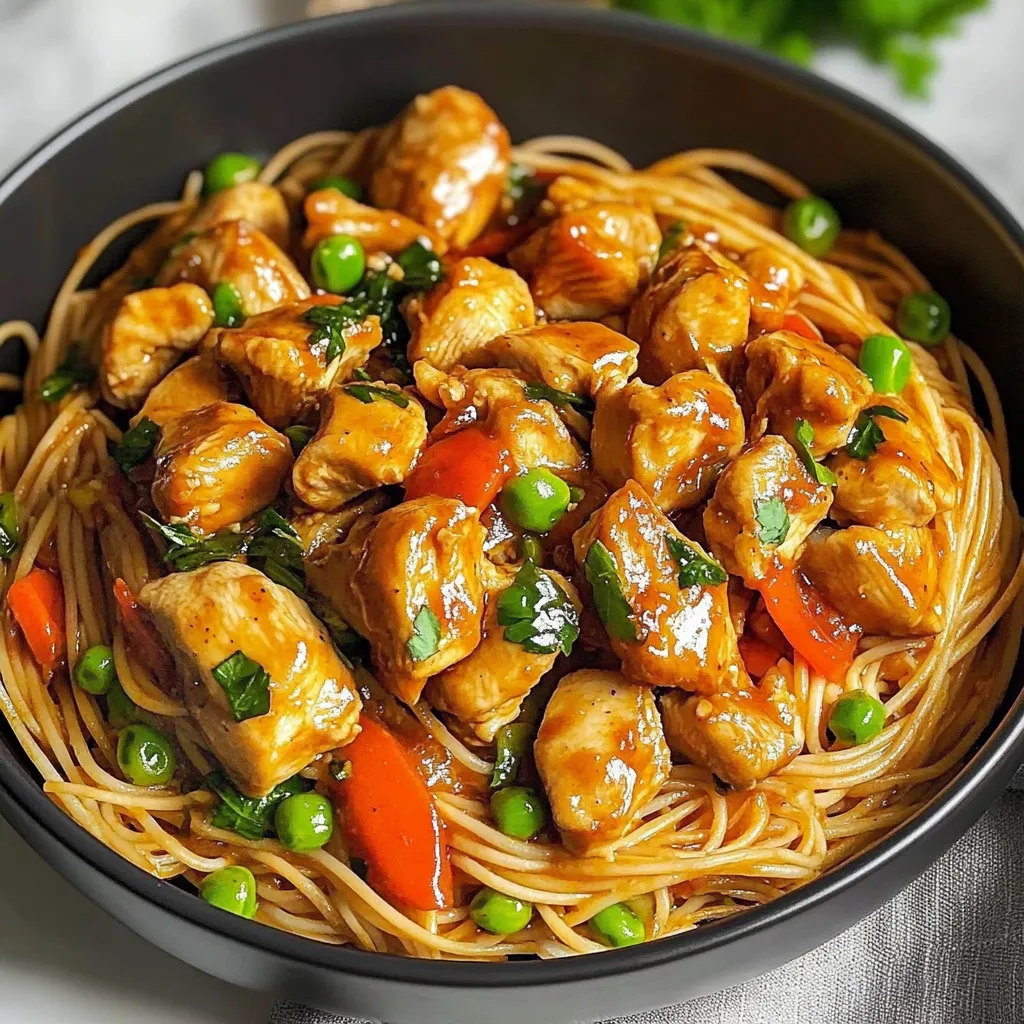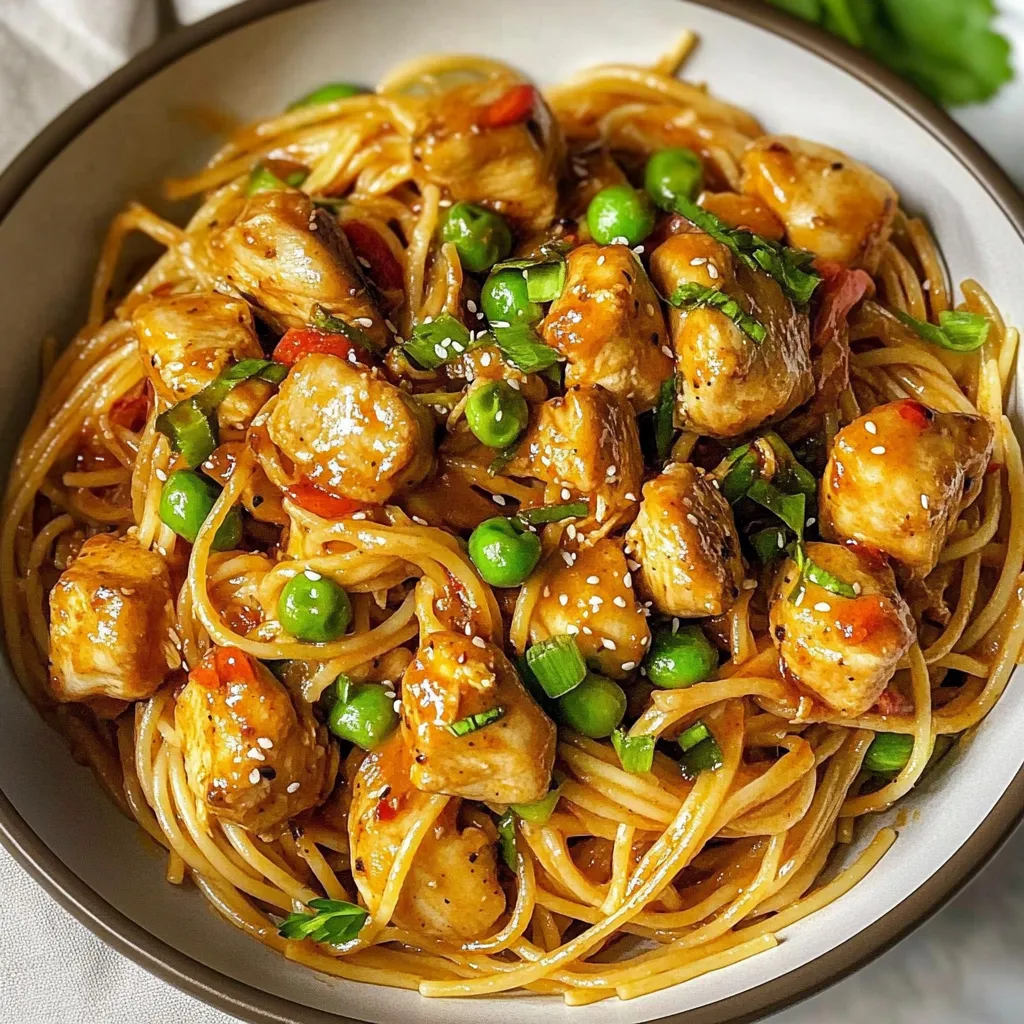 Pin
Pin
This Chinese Chicken Spaghetti brings together the best of both worlds with Italian pasta and Asian flavors. The tender chicken pieces and crisp vegetables are coated in a savory soy-based sauce that transforms ordinary spaghetti into something truly special. Perfect for weeknight dinners when you're craving takeout but want something homemade instead.
I first made this when my usual Chinese takeout place was closed during a holiday weekend. My family loved it so much that it quickly became our Monday night tradition when we want something quick but impressive.
Ingredients
- Spaghetti: serves as the perfect base to soak up the flavorful sauce. Look for quality pasta that has a slightly rough texture to better hold the sauce
- Cornstarch: creates the perfect coating for the chicken and helps thicken the sauce. Always mix with liquid first to prevent lumps
- Reduced sodium soy sauce: provides rich umami flavor without overwhelming saltiness. The reduced sodium version gives you better control over the salt level
- Sesame oil: adds authentic Asian flavor. Use pure toasted sesame oil for the best taste
- Boneless skinless chicken breasts: stay tender and cook quickly. Make sure to cut into even pieces for consistent cooking
- White vinegar: adds brightness to balance the savory elements. Rice vinegar works beautifully too if you have it
- Sugar: balances the acidity and enhances all other flavors. Use regular granulated sugar
- Snow peas: provide fresh crunch and vibrant color. Look for bright green pods that snap when bent
- Shredded carrots: add sweetness and beautiful color contrast. Fresh carrots have the best texture and flavor
- Green onions: bring a mild onion flavor that perfectly complements Asian dishes. Use both white and green parts
- Fresh gingerroot: adds essential warming spice. Choose firm pieces with smooth skin for the freshest flavor
- Red pepper flakes: add customizable heat. Adjust according to your spice preference
Step-by-Step Instructions
- Cook the Pasta:
- Bring a large pot of salted water to a rolling boil. Add spaghetti and cook according to package directions until al dente usually 8 to 10 minutes. Stir occasionally to prevent sticking. Reserve about 1/4 cup of pasta water before draining in case you need to loosen the sauce later.
- Prepare the Chicken Marinade:
- In a small bowl whisk cornstarch and 1 tablespoon soy sauce until completely smooth with no lumps. Then stir in 1 tablespoon sesame oil until well combined. This mixture creates a velvety coating that will protect the chicken during cooking and help create a silky sauce.
- Marinate the Chicken:
- Transfer the cornstarch mixture to a shallow dish. Add the chicken pieces and turn gently to ensure each piece is evenly coated. Let stand for exactly 10 minutes. This brief marinating time tenderizes the meat without making it too soft.
- Make the Sauce:
- While chicken marinates combine vinegar sugar and the remaining 3 tablespoons soy sauce and 1 tablespoon sesame oil in a small bowl. Whisk until sugar completely dissolves. This balanced sauce will bring all the elements together with the perfect combination of salty sweet and tangy flavors.
- Cook the Chicken:
- Heat canola oil in a large nonstick skillet or wok over medium high heat until shimmering but not smoking. Add the marinated chicken pieces in a single layer giving them space to brown properly. Cook and stir until chicken is no longer pink and reaches 165°F about 5 to 7 minutes. Remove chicken to a clean platter and cover loosely to keep warm.
- Stir Fry the Vegetables:
- In the same pan add snow peas and carrots capturing all the flavorful bits left from cooking the chicken. Stir fry continuously for 5 minutes until vegetables begin to soften but remain crisp. Add green onions ginger and red pepper flakes continuing to stir for another 2 to 3 minutes until vegetables reach the perfect crisp tender texture.
- Combine Everything:
- Return the cooked chicken to the pan with the vegetables. Pour the prepared soy sauce mixture over everything and stir gently but thoroughly. Add the drained pasta and toss until all ingredients are evenly coated with sauce and heated through about 1 minute. If sauce seems too thick add a splash of reserved pasta water.
 Pin
Pin
Fresh ginger is absolutely my favorite ingredient in this dish. I always keep a hand of ginger in my freezer which makes it incredibly easy to grate directly into dishes like this. The aroma that fills my kitchen when the ginger hits the hot pan reminds me of my favorite restaurant in Chinatown where I first fell in love with Asian cooking.
Make Ahead and Storage
This Chinese Chicken Spaghetti actually tastes even better the next day after the flavors have had time to meld together. Store leftovers in an airtight container in the refrigerator for up to 3 days. When reheating add a small splash of water to restore moisture and prevent dryness. The pasta will absorb some of the sauce overnight so this little trick brings it back to life perfectly.
Smart Substitutions
This recipe welcomes adaptations based on what you have available. Whole wheat spaghetti works beautifully for a nutrition boost. Beef or shrimp can replace chicken for variety. For a vegetarian version try using pressed extra firm tofu or simply double the vegetables. Broccoli mushrooms bell peppers or bok choy all make excellent additions or substitutions for the snow peas and carrots.
Serving Suggestions
Serve this vibrant dish family style in a large shallow bowl garnished with additional sliced green onions and sesame seeds. A side of simple cucumber salad dressed with rice vinegar provides a refreshing contrast. For a complete meal experience offer small bowls of chili oil garlic sauce and extra soy sauce at the table allowing everyone to customize their portion to taste.
 Pin
Pin
Cultural Context
This fusion dish beautifully bridges Italian and Chinese culinary traditions. While not traditionally Chinese the combination of Asian flavors with Western pasta creates an accessible entry point to Asian cooking techniques. The velveting technique used for the chicken marinade is authentically Chinese a method that restaurants use to create incredibly tender meat that remains juicy throughout cooking.
Recipe FAQs
- → Can I use other pasta shapes instead of spaghetti?
Absolutely! While spaghetti works well for twirling with the vegetables, you can substitute with lo mein noodles, linguine, or even rice noodles for a more authentic Asian texture. Just adjust cooking times according to the package directions.
- → How can I make this dish spicier?
To increase the heat level, simply double the crushed red pepper flakes or add a tablespoon of sriracha or chili garlic sauce to the soy sauce mixture. You could also include thinly sliced fresh chili peppers with the vegetables.
- → Can I make this dish vegetarian?
Yes! Replace the chicken with firm tofu (pressed and cubed) or 2 cups of mixed mushrooms. For additional protein, add 1 cup of edamame beans when you add the snow peas and carrots.
- → What vegetables can I substitute if I don't have snow peas?
Sugar snap peas, green beans, or broccoli florets make excellent alternatives to snow peas. You could also use sliced bell peppers, zucchini, or baby bok choy. The key is to maintain a similar cooking time to keep the vegetables crisp-tender.
- → Can I prepare components of this dish ahead of time?
Yes! To streamline dinner preparation, you can marinate the chicken up to 4 hours in advance (refrigerated), chop all vegetables the night before, and even mix the sauce ingredients ahead of time. Store components separately in the refrigerator until ready to cook.
- → Is this dish suitable for freezing?
While it will remain safe to eat when frozen and thawed, the texture of the vegetables and pasta may become softer. If you plan to freeze, slightly undercook the vegetables and pasta. Reheat gently in a skillet with a splash of water or chicken broth to refresh the sauce.
